How to Train a Dog: Positive Reinforcement Methods
Dog training doesn’t have to be a chore – with the right know-how, you can turn it into a fun bonding experience for both you and your furry friend. In this article, we’ll walk you through a simple step-by-step guide to training your dog and developing those good habits and behaviours that will make them a pleasure to live with. From potty training and basic commands to curbing problem behaviours, we’ve got all the tips and tricks you need to get your pup on the right track. With a positive approach and a little patience, you’ll be amazed at how quickly your four-legged companion picks things up. So grab some treats, your clicker and get ready to have some fun – it’s time for training!
Setting Yourself Up for Success: Preparing for Dog Training
House training a dog requires patience and persistence. To start, gather some essential supplies to help make the process easier. Things like treats, a harness and leash, bedding, toys, food and water bowls, and cleanup materials should be on your list.
Find a Safe Space
Designate an area in your home where your dog can stay when you’re not home to supervise. A room like a kitchen, laundry room or bathroom works well. Make sure there’s nothing your dog can get into that might harm them. Place bedding, food, water and toys in this space.
Establish a Routine
Developing a regular feeding, walking, and bathroom schedule will help your dog learn what’s expected of them. Take your dog out frequently, especially after they eat or drink. Always take them out the same door and use the same spot in the yard. With consistency, they’ll get accustomed to going in that area.
Be Patient and Offer Lots of Praise
Accidents will happen, so try not to punish or yell at your dog. Gently clean up any messes and take responsibility for not properly supervising them. Lavish your dog with praise and treats when they go in the right area. Your positive reinforcement will help speed the learning process.
With time and consistency, your dog will get the hang of things. But even after house training is complete, regular supervision and opportunities to go out are still important. Be patient through challenges and celebrate milestones together. The rewards of a well-trained companion will make it all worthwhile!
Basic Obedience Commands to Teach Your Dog
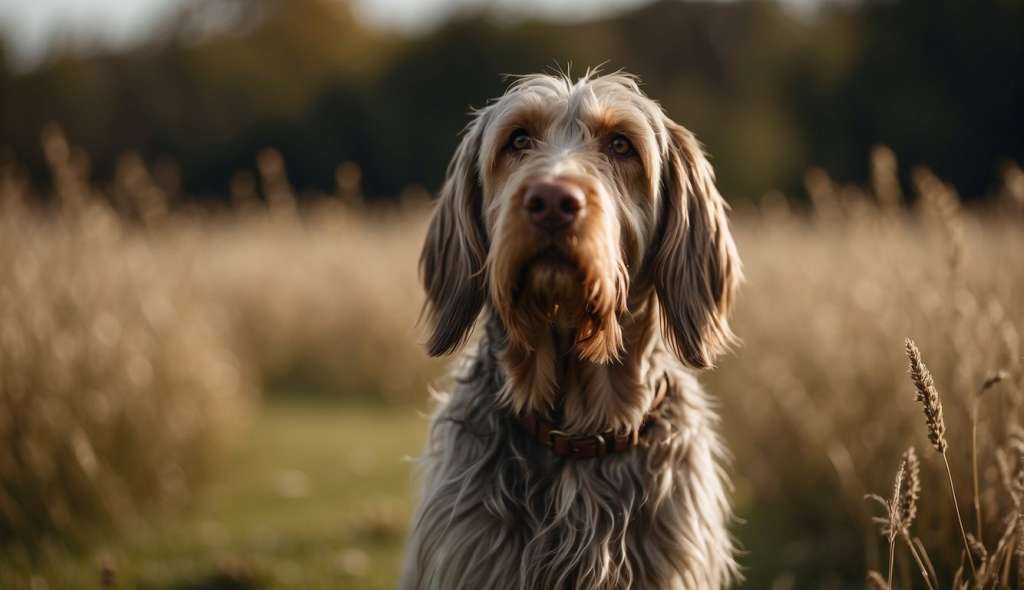
Teaching your dog basic commands is essential for behaviour and building a bond of trust. The first command to teach is ‘sit’. To teach your dog to sit, hold a treat above their head and say ‘sit’. If they sit, reward them immediately with the treat and praise. Repeat this until they learn to associate the command and action.
Come
Teaching your dog to come when called is important for their safety. Attach a long lead to their collar and let them wander, then call ‘come’ while gently pulling on the lead. When they come, reward them with a treat. Practice this on the lead until they respond well, then try it off the lead in a contained area. Reward and praise them enthusiastically when they come.
Stay
‘Stay’ teaches your dog impulse control and patience. Have your dog sit, hold a treat in front of their nose and say ‘stay’. If they remain sitting, reward them. Work up to more time between the command and reward. Release them from the stay with ‘OK’. Start with short periods, around 5-10 seconds, and gradually increase the time. Provide lots of praise when they stay put.
Leave it
The ‘leave it’ command teaches your dog to ignore distractions. Hold a treat in your hand, say ‘leave it’ and close your hand. If your dog moves away from your hand, reward them with a treat from the other hand. Practice with various items on the floor, rewarding your dog for leaving them. This command helps build self-control in stimulating situations.
With patience and consistency, your dog will master these basic commands. Be sure to use positive reinforcement training, with rewards and praise. Keep training sessions short and fun. If you follow these techniques, you’ll have a well-trained companion in no time!
Effective Training Methods: Positive Reinforcement
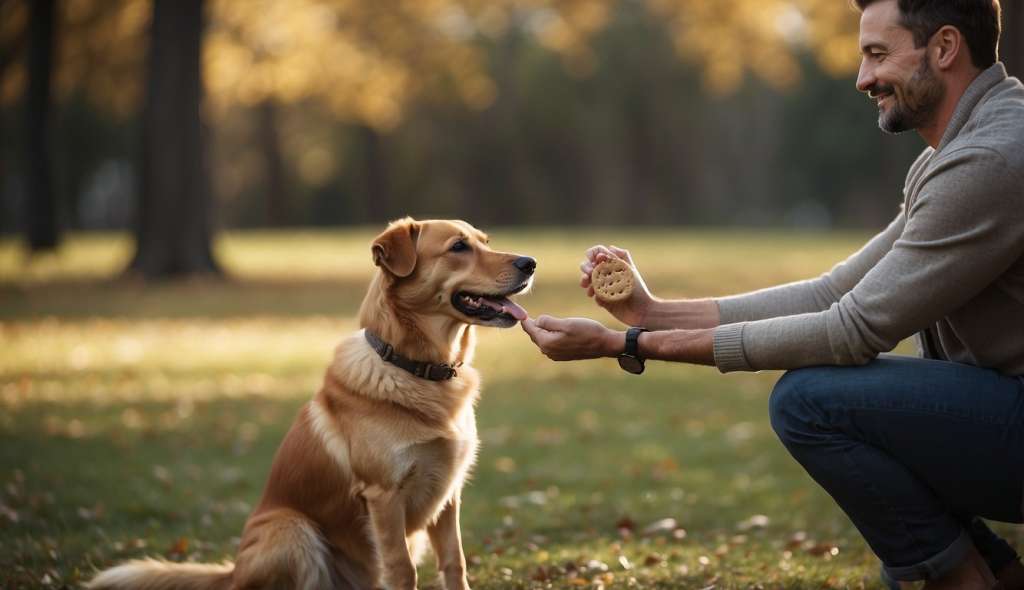
Positive reinforcement training is one of the most effective ways to train a dog. This technique focuses on rewarding your dog when they demonstrate the behaviour you want to see.
Reward-Based Training
The core idea of reward-based training is to give your dog treats, praise, or play when they respond well to a command. For example, when your dog sits on command, reward them with a treat and enthusiastic praise. This helps them associate the command and action with reward, making them eager to repeat it.
Reward-based training is extremely effective because dogs have a strong instinct to seek rewards. Keep training sessions short, around 5 to 10 minutes, and end on a high note. This will leave your dog wanting more and looking forward to the next session.### Clicker Training Clicker training is a popular form of reward-based training. A clicker is a small device that makes a distinct clicking sound when pressed. You teach your dog that the sound of the clicker means a treat is coming. Once your dog has learned this connection, you can start using the clicker to mark correct behaviours, followed immediately by a treat.
The click has the advantage of being a very clear signal to your dog that they did something right. It allows you to precisely mark the behaviour you want to reinforce. The treat then serves as the actual reward.
Avoid Punishment
Punishment-based training methods, like scolding or physically correcting your dog, are counterproductive and can damage your bond of trust. They teach your dog to fear you and associate training with negative experiences. Reward-based methods, on the other hand, strengthen your connection and make learning fun for your dog. For the most effective and humane training, always focus on positive reinforcement of good behaviours rather than punishing unwanted ones.
With patience and consistency, reward-based training methods will help you teach your dog proper behaviour and build a lifelong bond of trust and respect. Keep training sessions positive and fun, give clear commands and clicker feedback, and reward your dog generously with treats, play, and praise. Before you know it, you’ll have a happy, well-trained companion by your side.
Common Dog Behaviour Issues and How to Correct Them
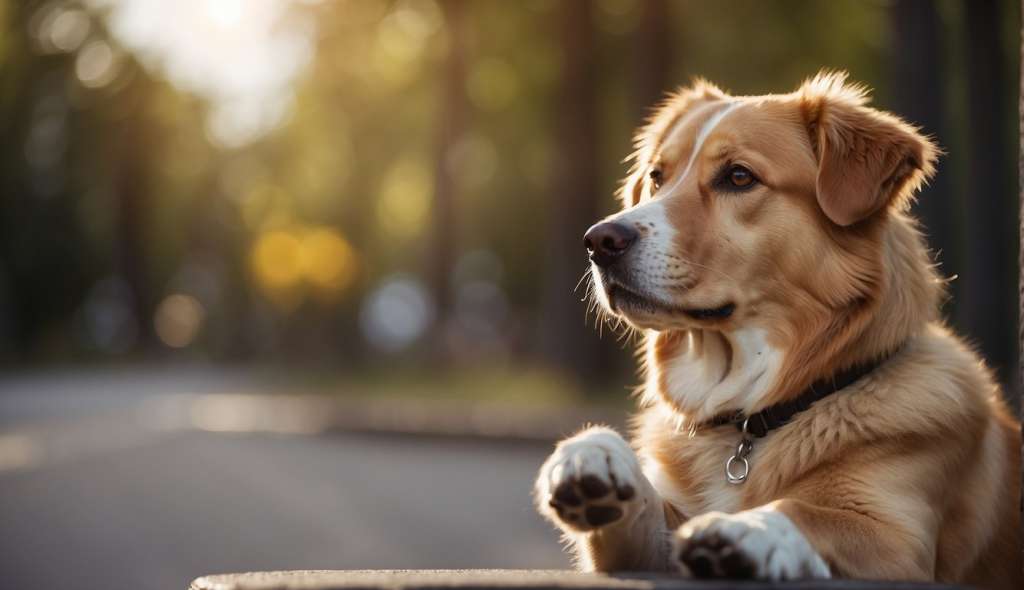
Anxiety and Restlessness
Some dogs may experience anxiety and restlessness, especially if left alone for long periods. To help reduce anxiety in dogs, it is important to give them plenty of exercise and play. Provide interactive dog toys to keep them stimulated when alone. You can also leave on a radio, TV or audiobook to prevent them from feeling isolated.
Excessive Barking
Excessive barking can be annoying for owners and neighbours. It is best to determine the cause of the barking and take steps to reduce it. Sometimes dogs bark out of boredom, so provide exercise and interactive toys. They may also bark for attention, so avoid rewarding the barking by not giving them attention when they’re being vocal. You can also use the ‘quiet’ command and reward them when they stop barking.
Aggression
Dog aggression can be dangerous and complex to address. It is best to consult a professional dog behaviourist. They can evaluate the cause of aggression and provide guidance for management and training. Socialisation and positive reinforcement training from an early age can help prevent aggression. Always supervise dogs around strangers and other dogs.
Destructive Behaviour
Destructive behaviour like chewing furniture or shoes usually happens when dogs are bored, anxious or seeking attention. Provide plenty of exercise and play, interactive dog toys and chew toys. You should also puppy-proof the home by removing or securing items you do not want chewed. Reward and praise your dog when they chew appropriate toys. Crate training can also help prevent destructive behaviour in the short term.
With time, patience and consistency, many common behaviour issues in dogs can be resolved or improved. However, for severe or aggressive behaviours, it is best to seek help from a qualified dog behaviourist. They can evaluate the situation, determine the cause of problems and provide guidance tailored to your dog’s needs.
Advanced Dog Training Techniques
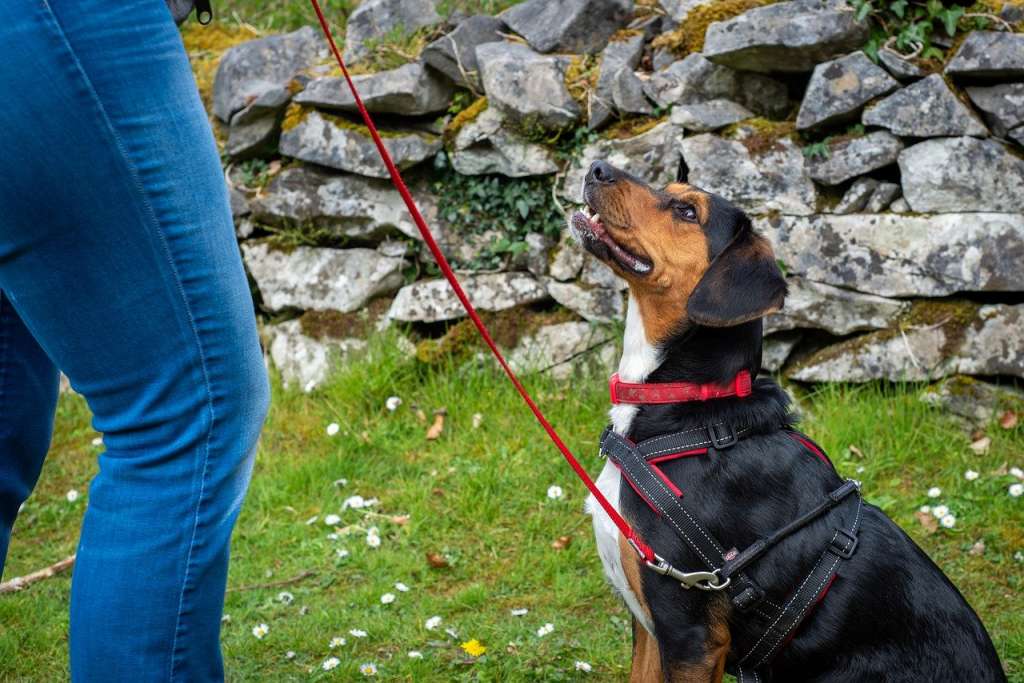
Once a dog has mastered the basics, owners can move on to more advanced techniques to keep training challenging and engaging.
Hand Signals
Hand signals are a useful way to communicate with a dog from a distance or in loud, distracting environments where verbal commands may not be effective. To teach hand signals, owners should start with simple commands the dog already knows, like ‘sit’. Give the verbal cue and hand signal at the same time, then reward the dog when it responds. Repeat this process until the dog begins to associate the hand signal with the command.
Heel Training
Heel training teaches a dog to walk calmly at the owner’s side. Owners should start heel training in a quiet area without distractions. Give the ‘heel’ command while walking, and reward the dog when it walks in the proper position. If it forges ahead or lags behind, stop walking until it returns to the proper position. With regular practice, a dog will learn to heel on command during walks.
Loose-leash Walking
Loose-leash walking is an important skill for any dog to master. To train a dog to walk calmly on a leash, owners should stop walking when the leash goes taut. Only continue walking when the leash relaxes. This technique teaches a dog that pulling will not be rewarded. Owners should also reward and praise the dog when the leash remains loose. With consistency and patience, many dogs can become comfortable walking calmly on a loose leash.
Owners should start slowly and keep advanced training sessions short and positive. Harsher discipline will likely backfire and damage the owner’s relationship with their dog. While training an older dog requires more time and patience, even dogs with undesirable habits can become well-behaved and trusted companions with the proper technique and consistency. Advanced skills take significant time and practice, but will provide mental stimulation for dogs and give owners more control and confidence during walks or public outings.
Troubleshooting Common Dog Training Problems
Potty Training Accidents
Accidents happen, especially when potty training a new puppy. The key is to be patient and stick to a regular feeding and bathroom schedule. Take the dog out frequently, especially after they eat, drink or wake up. When accidents do occur, never punish the dog. Simply clean up the mess thoroughly using an odour eliminator to remove the smell which can attract the dog back to the same spot. With consistency and time, potty training a puppy does get easier.
Excessive Barking
Dogs bark for many reasons, including excitement, anxiety, attention seeking or as an alarm. The first step is determining the cause of the barking by observing your dog’s body language and the situation. You may need to avoid triggers like sounds that startle your dog. Also, make sure your dog gets plenty of exercise which can help reduce anxiety and boredom. When your dog barks, avoid rewarding the behaviour by not giving them attention. Instead, reward and treat your dog when they are quiet. You can also teach the ‘Quiet’ command by saying ‘Quiet’, waiting for your dog to stop barking and then treating and praising them. With practice and consistency, excessive barking can be reduced.
Aggression
Aggressive behaviour in dogs can be dangerous, so it’s important to address it responsibly. Some aggression is caused by fear or anxiety, in which case avoiding triggers, socialization and training confidence-building commands can help. You may also need to consult a professional dog behaviourist. For aggression caused by guarding resources like food, teach your dog appropriate behaviour through training. Provide plenty of exercise which can help reduce aggression caused by excess energy or frustration. Never punish or yell at an aggressive dog, as this will likely make the aggression worse. Always remain calm and in control, using positive reinforcement training. Aggression is a serious issue, so getting guidance from a professional is often the most responsible approach.
With time, patience and consistency, many common dog training problems can be resolved or at least improved. However, some issues may require consulting a professional dog trainer to help set you and your dog up for success.
How Long Should You Train Your Dog Each Day?
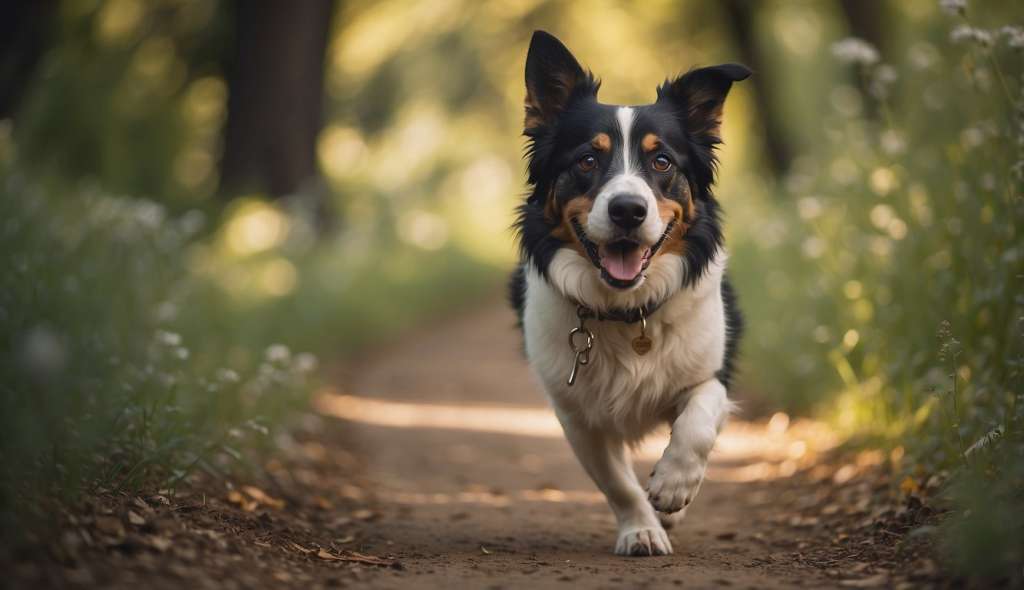
When it comes to training your dog, consistency and repetition are key. However, you don’t want to overdo it, as too much training can lead to boredom and frustration for you both. As a general rule of thumb, keep training sessions short and positive, around 5 to 10 minutes for puppies and 10 to 15 minutes for adult dogs.
Within those short periods, work on one skill or command at a time, repeating it multiple times while keeping things fun and rewarding. Start with the basics like ‘sit,’ ‘stay’ and ‘come,’ and once your dog has mastered those, move on to more complex commands or tricks. Provide plenty of praise, treats and play to keep your dog engaged.
It’s also a good idea to train your dog at the same time every day, such as before breakfast or dinner when they’re more likely to be focused. For the best results, aim for two to three training sessions per day. Be patient through the process, as some dogs may pick up on skills quickly while others require more time and practice.
If at any point your dog seems bored or frustrated, simply end the session on a high note and try again later. It’s better to keep things short and positive rather than drag on for too long. Also, once your dog has learned a new skill, continue reinforcing it with practice and intermittent treats to make sure they retain it.
Overall, when determining how long and how often you should train your dog, make sure you consider their age, attention span, and temperament. An older, more rambunctious dog may require shorter, more frequent sessions, while a younger dog may be able to focus for longer periods if you keep things fun and engaging. The key is to find what works for you and your dog’s unique situation. With time and consistency, you’ll get the hang of it!
Potty Training Your Puppy
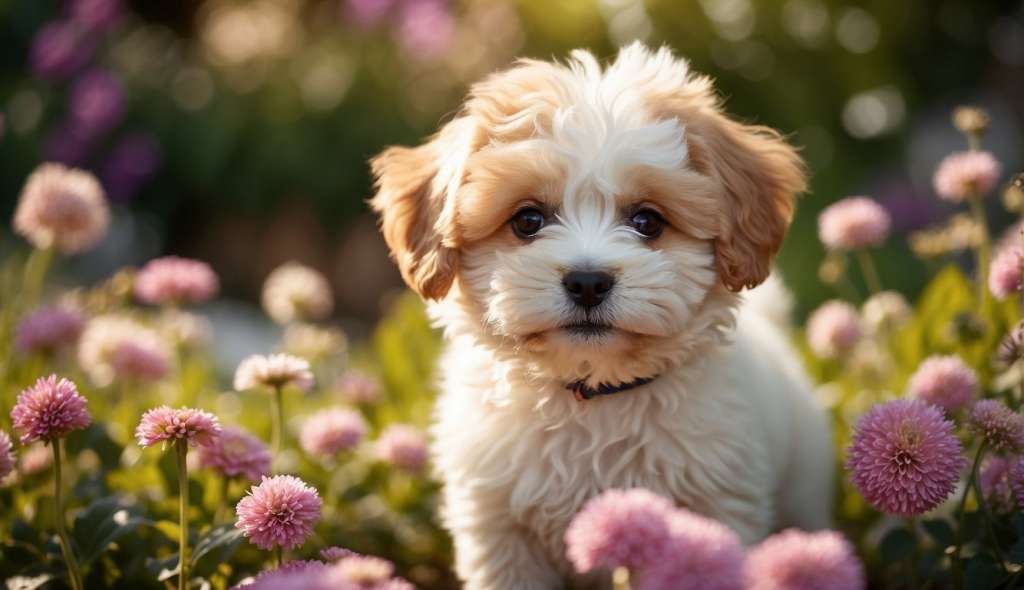
Potty training is one of the first things you need to tackle when bringing home a new puppy. Consistency and patience are key. Here are the steps you should take:
- Take your puppy outside frequently – every 1-2 hours at first. Right after they wake up, eat or play, take them outside.
- Use a command like “go potty” when they start to relieve themselves. This will teach them the cue.
- Praise and reward your puppy heavily when they go where they’re supposed to. Treats and affection work wonders.
- Watch your puppy closely for signs they need to go out like circling, sniffing and whining. Take them outside immediately at these cues.
- When you can’t watch your puppy, put them in a confined area like a pen or crate to limit opportunities for accidents.
- If you catch your puppy in the act of an accident, say “no” firmly and take them outside. Clean the area with an enzymatic cleaner.
- Be consistent – stick to the same routine and commands. Repetition is how puppies learn.
With patience and consistency, most puppies are fully potty trained within a few months. Accidents will happen, so stay positive and never punish your puppy after the fact – just clean up and get back to training. Over time your puppy will learn that going outdoors is the right thing to do.
Choosing the Right Dog Trainer
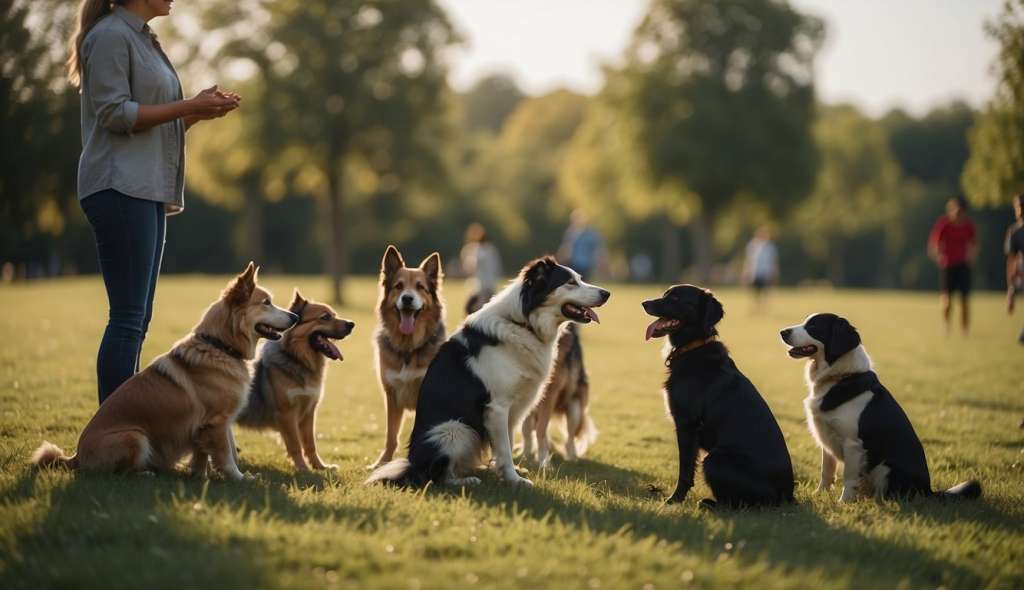
When it comes to training a dog, finding the right trainer is key. Look for a trainer who uses positive reinforcement techniques, like treats, play, and praise, rather than punishment. A good trainer will have experience, credentials, and of course, a genuine love of dogs.
Ask potential trainers about their experience and education. Many reputable trainers will have certifications from organizations like the Certified Professional Dog Trainer (CPDT). See if the trainer has experience with your dog’s breed or age. Some specialize in puppy training, while others focus on aggression or anxiety.
Meet with trainers you’re interested in and ask them about their training philosophy and techniques. A good trainer will focus on positive reinforcement and reward-based training. They should never use physical punishment, yelling, or dominance techniques, which have been disproven and can damage your bond with your dog.
Discuss your dog’s specific needs and goals to make sure the trainer’s approach is a good fit. Every dog has a unique personality, so look for a trainer willing to tailor a program to your dog’s abilities and temperament. Ask the trainer to evaluate your dog in person to determine their strengths, weaknesses and the best way to motivate them.
Price varies, but group or private classes typically range from £30 to £100 per session. In-home private training is usually £100 or more. While cost is a factor, don’t choose a trainer based primarily on price. An experienced, skilled trainer will help you build a lifelong bond with your dog, so they’re worth the investment.
With the right trainer, your dog can master basic cues like ‘sit,’ ‘stay’ and ‘come,’ as well as address any behavioral issues. But training isn’t just about commands–it’s about developing communication and trust between you and your dog. The most important thing is finding a trainer who understands this and will guide you in forging a positive relationship based on mutual understanding and respect.
How to Train a Dog FAQs: Your Top Training Questions Answered
Dog training can seem complicated, but with patience and consistency, you’ll get the hang of it. Here are some of the most frequently asked questions from dog owners about how to train their furry friend.
One of the most common questions is:
When should I start training my dog?
It’s best to start training your dog as early as possible. Begin simple training like ‘sit’, ‘stay’ and ‘come’ as soon as you bring your dog home. Use positive reinforcement with treats and praise to help them learn. Short, frequent training sessions are most effective for puppies.
Another FAQ is:
How do I stop my dog from barking excessively?
Excessive barking can be difficult to control, but with consistent training you can teach your dog the ‘quiet’ command. When your dog barks, say ‘quiet’, wait for them to stop barking, even if just for a second, then praise and treat. This helps them learn being quiet gets rewarded. You should also avoid inadvertently reinforcing the barking by not giving your dog attention when they’re being noisy.
Many owners ask:
How can I get my dog to stop jumping up?
To train your dog not to jump up, ignore the behaviour by avoiding eye contact, turning away and not pushing them down. When your dog has all four paws on the ground, say ‘off’, wait a few seconds, then reward and praise. Ask friends to do the same. Consistency is key.
Finally, a popular question is:
How do I stop my dog from pulling on the lead?
Walking calmly on a lead takes practice. Use a front-attach harness, which is more comfortable and gives you more control. Stop walking when the lead is pulled, call your dog back to your side, and reward when they get there. Move off again. Repeat this, praising your dog for walking by your side. With consistency, they’ll learn that pulling gets nowhere, but walking calmly is rewarded.
Using rewards, consistency and patience, you can work through common training issues and have a well-behaved canine companion. If needed, consider hiring a professional dog trainer to help address any ongoing problems.
Conclusion
So there you have it – the essential steps for training your dog and developing a strong bond. While it takes time and patience, the payoff is huge. A well-trained dog is a pleasure to have around the house and out in public. More importantly, training establishes you as the pack leader and provides your dog with the structure and guidance they crave. Just remember to use positive reinforcement, keep sessions short and sweet, and end on a high note. Your dog will be heeling, sitting, staying and more in no time. The final result will be a happy, confident and obedient companion who respects you and enjoys spending time together.
